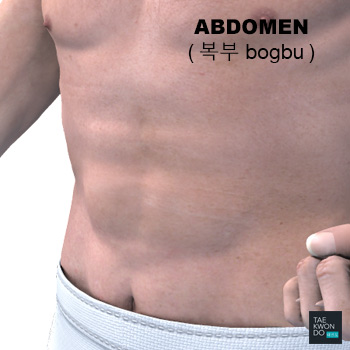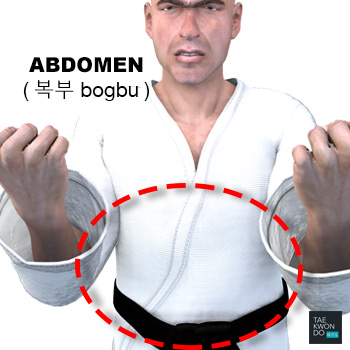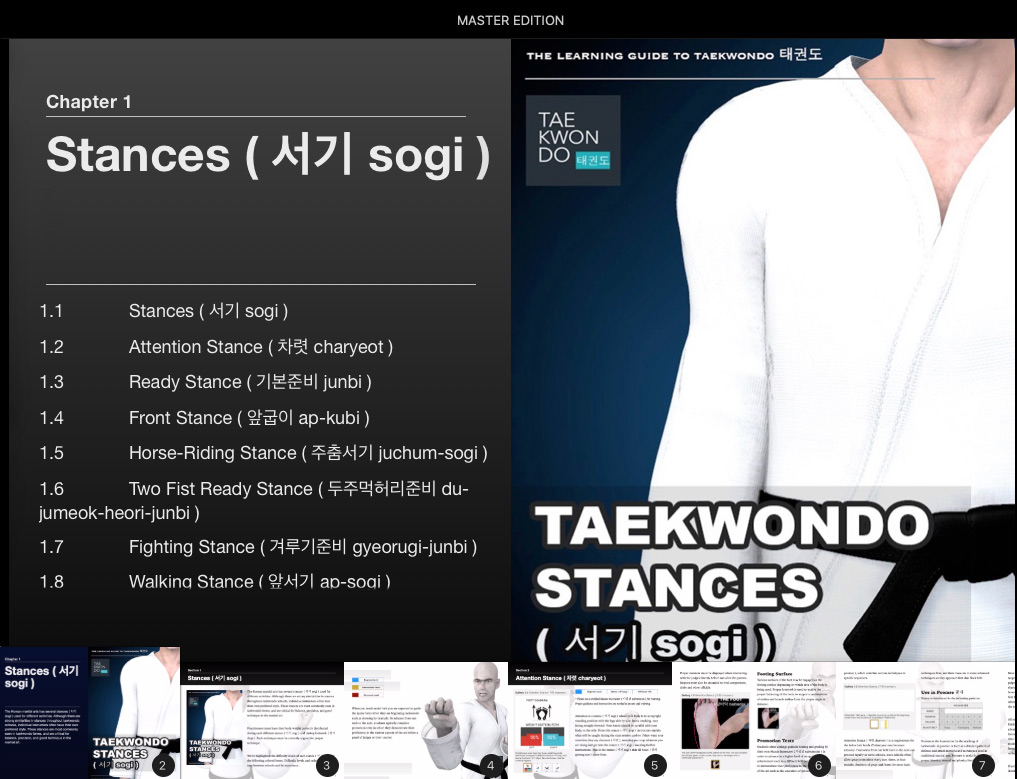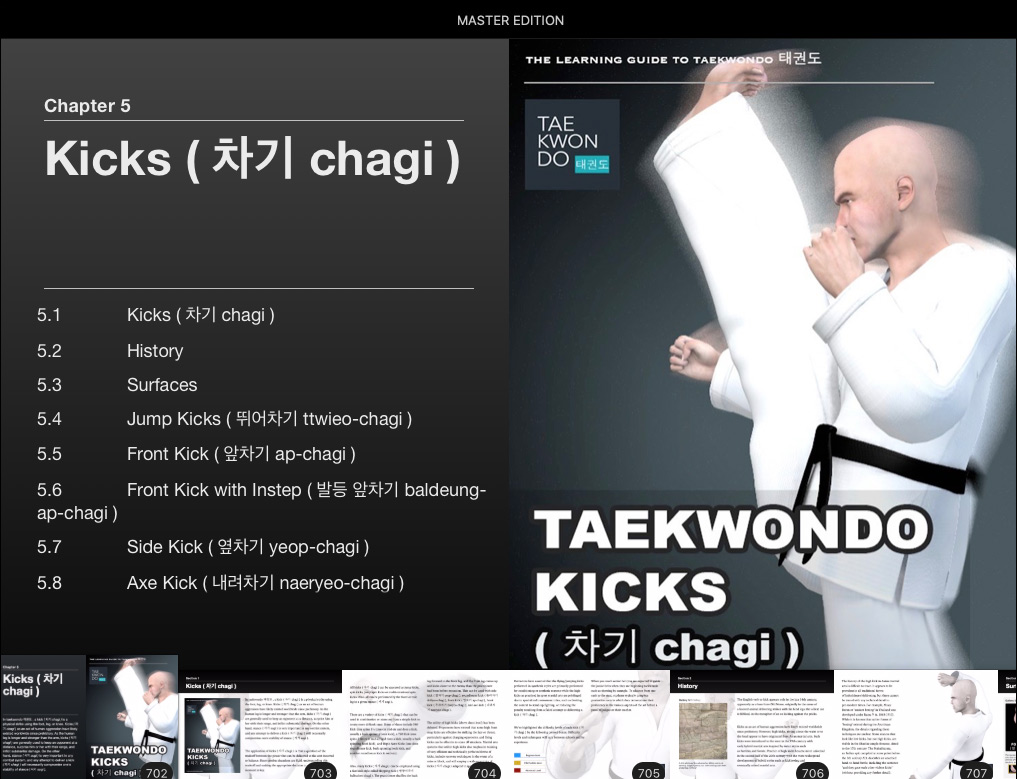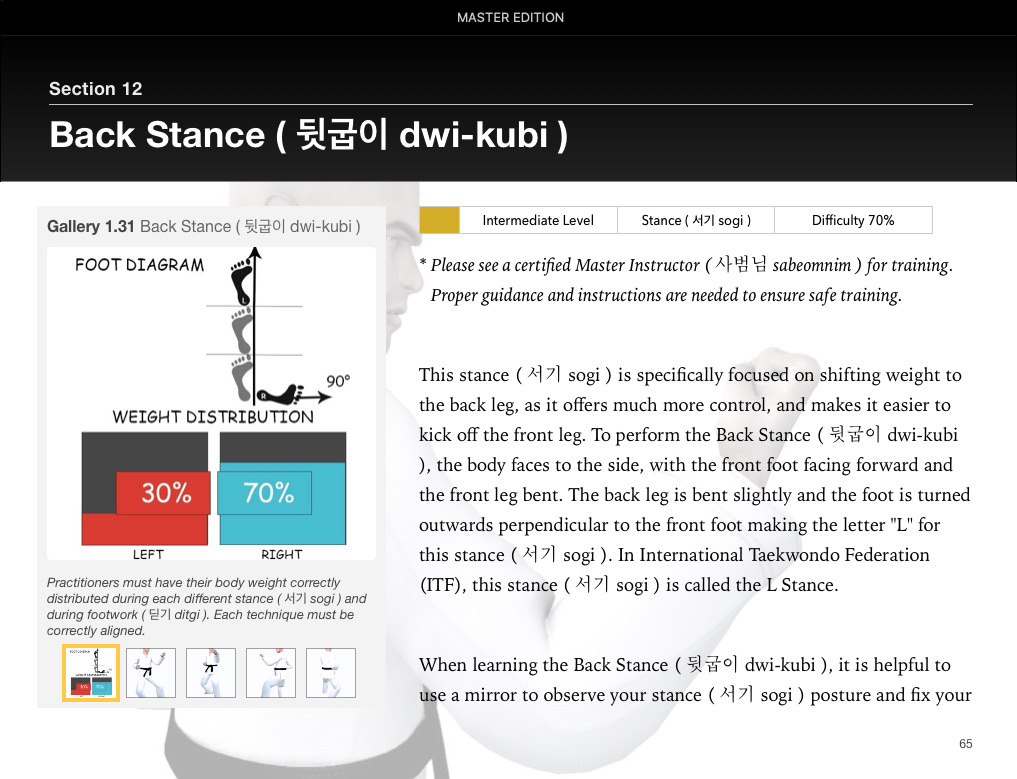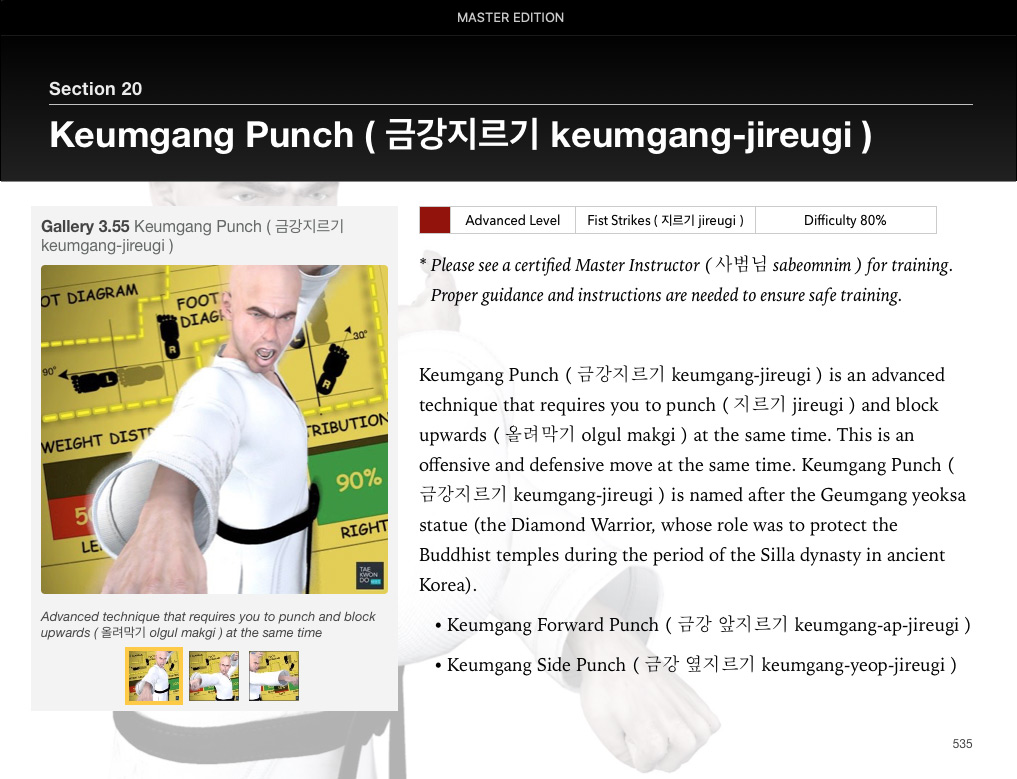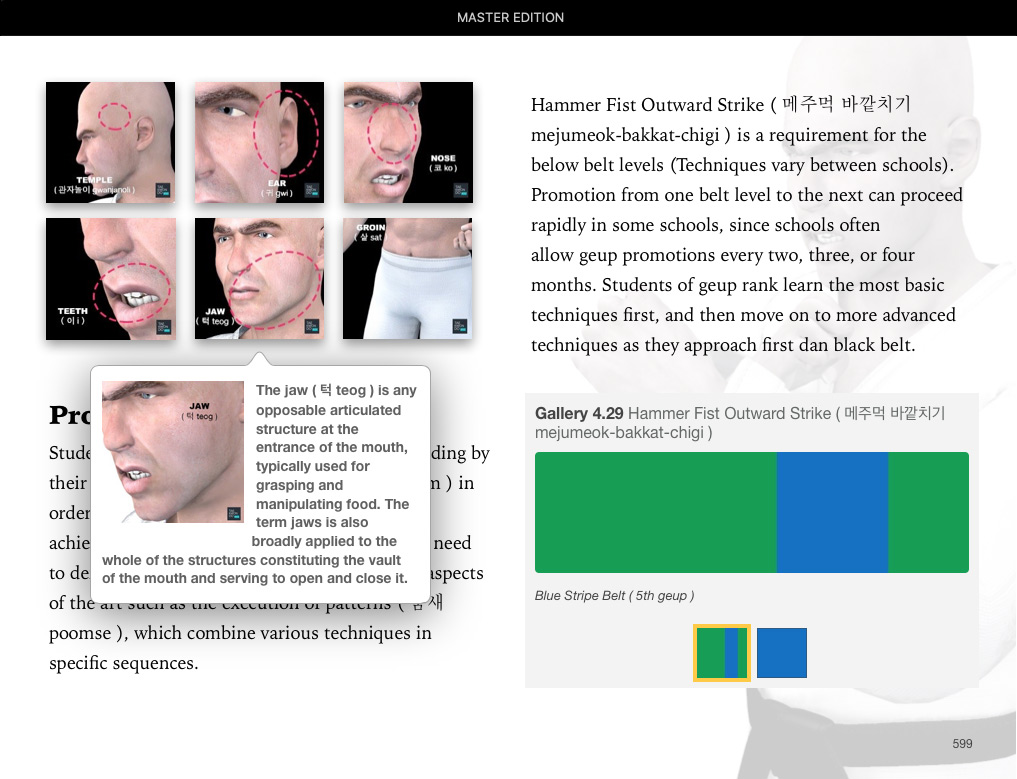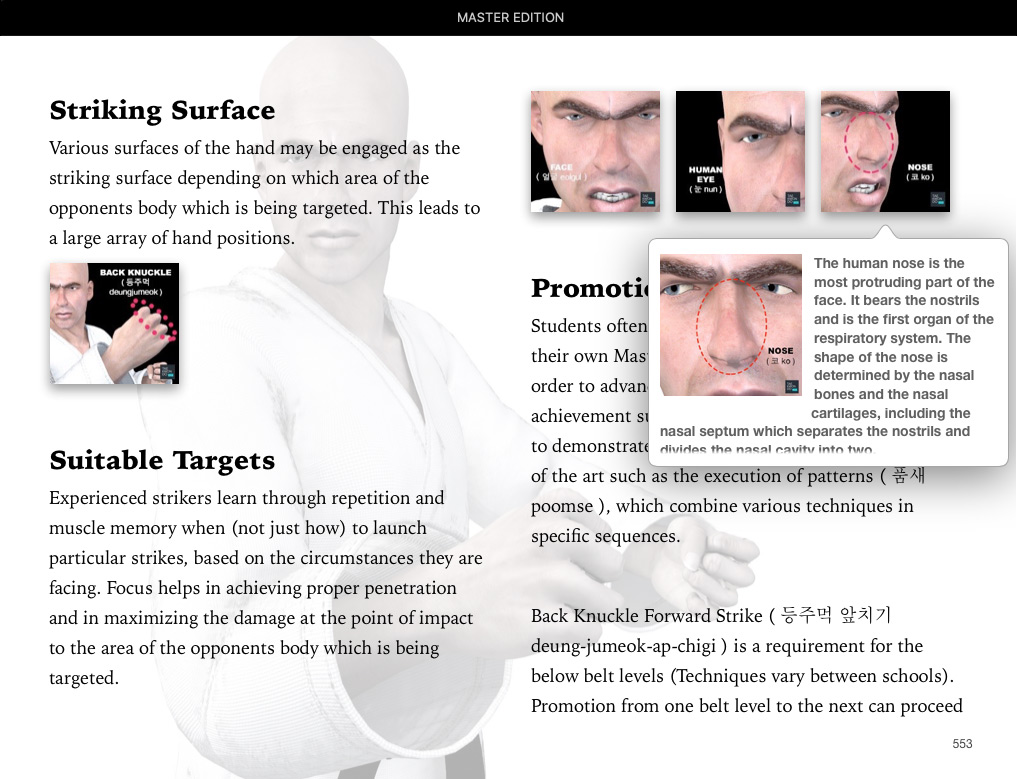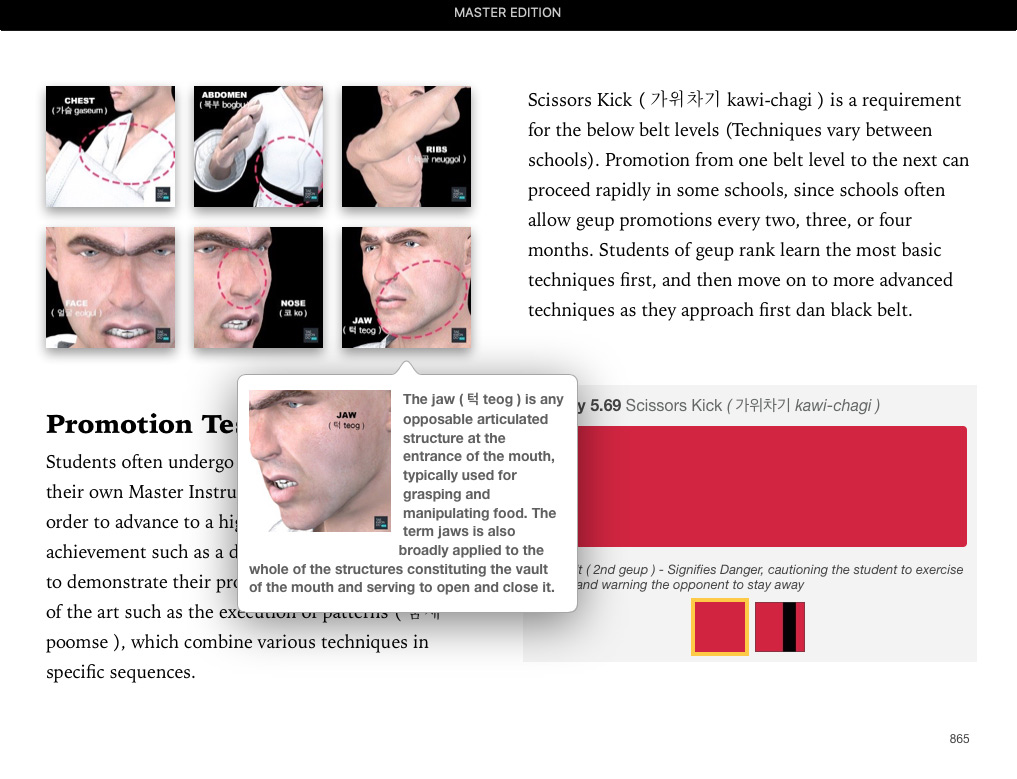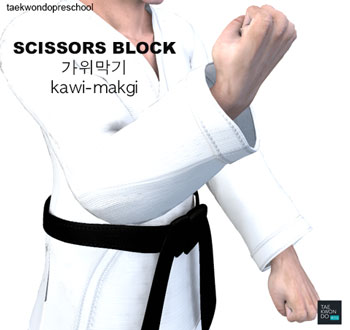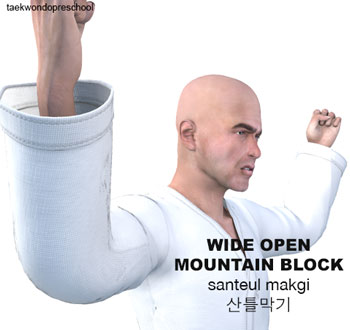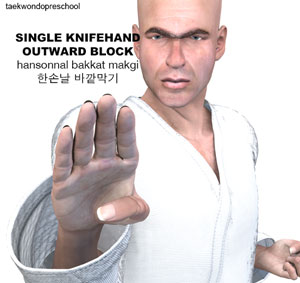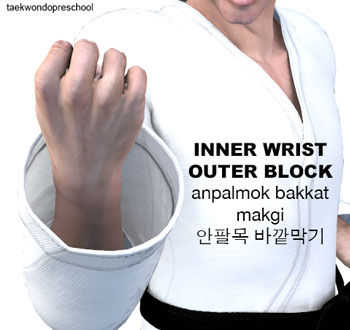Taekwondo 태권도Taekwondo Preschool
Promotion from one geup to the next can proceed rapidly in some schools, since schools often allow geup promotions every two, three, or four months. Students of geup rank learn the most basic techniques first, and then move on to more advanced techniques as they approach first dan. Many of the older and more traditional schools often take longer to allow students to test for higher ranks than newer, more contemporary schools, as they may not have the required testing intervals. View Taekwondo belt levels »
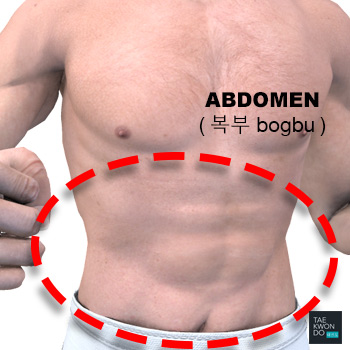
Abdomen
( 복부 bogbu )
Difficulty Level: Beginner Surface: Offensive Target
The abdomen (less formally called the belly, tummy or midriff) is the part of the body between the thorax (chest) and pelvis in humans. The abdomen is the front part of the abdominal segment of the trunk.
Being key elements of spinal support, and contributors to good posture, it is important to properly exercise the abdominal muscles together with the back muscles because when these are weak or overly tight they can suffer painful spasms and injuries. When properly exercised, abdominal muscles contribute to improved posture and balance, reduce the likelihood of back pain episodes, reduce the severity of back pain, protect against injury by responding efficiently to stresses, help avoid some back surgeries, and help with the healing of back problems, or after spine surgery.
The abdominal cavity contains most parts of the digestive tract, including the stomach, the small intestine, and the colon with its attached appendix. Other organs such as the liver, its attached gallbladder, and the pancreas function in close association with the digestive tract and communicate with it via ducts. The spleen, kidneys, and adrenal glands also lie within the abdomen, along with many blood vessels including the aorta and inferior vena cava.
Muscles
There are three layers of muscles in the abdominal wall. They are, from the outside to the inside: external oblique, internal oblique, and transverse abdominal. The first three layers extend between the vertebral column, the lower ribs, the iliac crest and pubis of the hip.
The transverse abdominal muscle is flat and triangular, with its fibers running horizontally. It lies between the internal oblique and the underlying transverse fascia. It originates from Poupart's ligament, the inner lip of the ilium, the lumbar fascia and the inner surface of the cartilages of the six lower ribs.
The rectus abdominis muscles are long and flat. The muscle is crossed by three fibrous bands called the tendinous intersections. The rectus abdominis is enclosed in a thick sheath, formed as described above, by fibers from each of the three muscles of the lateral abdominal wall. They originate at the pubis bone, run up the abdomen on either side of the linea alba, and insert into the cartilages of the fifth, sixth, and seventh ribs.
The pyramidalis muscle is small and triangular. It is located in the lower abdomen in front of the rectus abdominis. It originates at the pubic bone and is inserted into the linea alba halfway up to the navel.
* Please see a certified Master Instructor ( 사범님 sabeomnim ) for training. Proper guidance and instructions are needed to ensure safe training.

Impact Surface Area
Various surfaces of the hand and feet may be engaged as the striking or blocking surface depending on which area of the opponents body is being targeted. This leads to a large array of hand and feet positions. The human body's shape is determined by a strong skeleton made of bone and cartilage, surrounded by fat, muscle, connective tissue, organs, and other structures. For more information View Impact Surface Area »
- Fist ( 주먹 jumeok )
- Hammer Fist ( 메주먹 mejumeok )
- Hand Blade ( 손날 sonnal )
- Ridgehand ( 손날등 sonnal-deung )
- Forearm ( 앞팔 ap-pal )
- Inner Wrist ( 안팔목 anpalmok )
- Outside Wrist ( 바깥팔목 bakkatpalmok )
- Elbow ( 팔굽 palgup )
- Back Knuckle ( 등주먹 deung-jumeok )
- Arm ( 팔 pal )
- Hand ( 손 son )
- Finger ( 손가락 songalag )
- Palm ( 손바닥 sonbadak )
- Palm Heel ( 바탕손 batangson )
- Fingertips ( 손끝 sonkkeut )
- Scissors Fingertips ( 가위손끝 kawisonkkeut )
- Combined Two Fingertips ( 모은두손끝 moeundusonkkeut )
- Single Fingertip ( 한손끝 hansonkkeut )
- Combined Three Fingertips ( 모은세손끝 moeunsesonkkeut )
- Flat Fingertips ( 편손끝 pyeonsonkkeut )
- Back Hand ( 손등 sondeung )
- Wrist Area ( 팔목 palmok )
- Back of the Wrist ( 등팔목 deung-palmok )
- Base of the Wrist or Inner Wrist ( 밑팔목 mitpalmok )
- Arc Hand ( 아금손 ageumson )
- Pincers Finger ( 집게주먹 jipgejumeok )
- Bent Wrist ( 굽힌손목 gupinsonmok )
- Curled Fingertips ( 모둠손끝 modumsonkkeut )
- Extended Knuckle Fist ( 밤주먹 bamjumeok )
- Half-clenched Fist ( 편주먹 pyeonjumeok )
- Trigger Finger Fist ( 집게밤주먹 jipgebamjumeok )
- Curled Hand ( 곰손 gomson )
- Foot ( 발 bal )
- Ball of the Foot ( 앞축 apchuk )
- Instep of the Foot ( 발등 baldeung )
- Bottom of the Heel ( 뒤축 dwichuk )
- Sole of the Foot ( 발바닥 balbadak )
- Foot Blade ( 발날 balnal )
- Shin ( 정강이 jeonggangi )
- Ankle ( 발목 balmog )
- Reverse Foot Blade ( 발날등 balnaldeung )
- Tips of the Toes ( 발끝 balkkeut )
- Knee ( 무릎 mureup )
- Back of the Heel ( 뒤꿈치 dwikkumchi )
- Back of the Knee ( 오금 ogum )
- Thigh ( 허벅지 heobeokji )
- Head ( 머리 meoli )
- Face ( 얼굴 eolgul )
- Human Eye ( 눈 nun )
- Ear ( 귀 gwi )
- Temple ( 관자놀이 gwanjanoli )
- Nose ( 코 ko )
- Teeth ( 이 i )
- Chin ( 턱 teog )
- Jaw ( 턱 teog )
- Throat ( 목구멍 mokgumeong )
- Neck ( 목 mok )
- Cervical Vertebrae ( 경추 gyeongchu )
- Shoulder ( 어깨 eokkae )
- Collarbone ( 쇄골 swaegol )
- Chest ( 가슴 gaseum )
- Ribs ( 늑골 neuggol )
- Sternum ( 흉골 hyung-gol )
- Abdomen ( 복부 bogbu )
- Groin ( 샅 sat )
- Hamstring ( 햄스트링 haemseuteuling )
There are five tenets defined in the International Taekwondo Federation (ITF) and several more in World Taekwondo (WT).
Perseverance ( 인내 in-nae ): "One will persevere time and time again until they have achieved a result which is adequate towards what one was trying to achieve." View Taekwondo Tenets »
RESOURCES
This article uses material from the Wikipedia articles "Abdomen" and "List of Taekwondo techniques", which is released under the Creative Commons Attribution-Share-Alike License 3.0.


